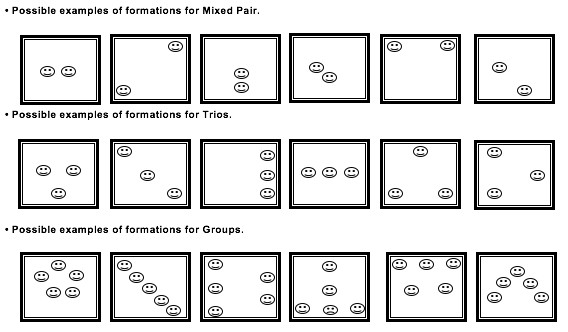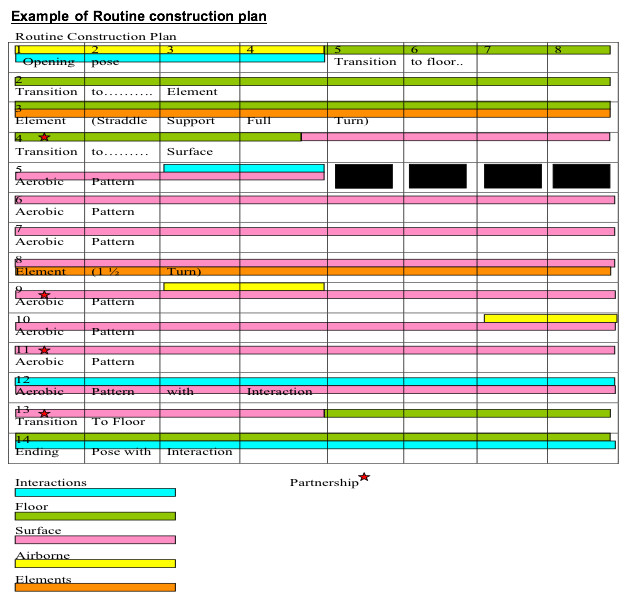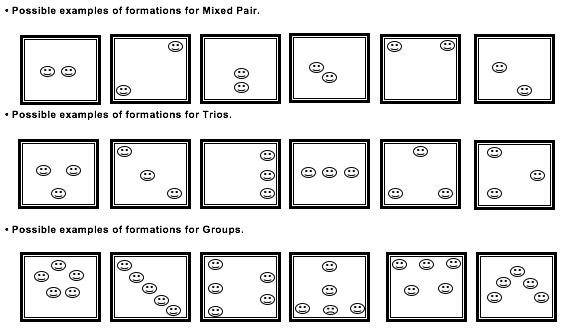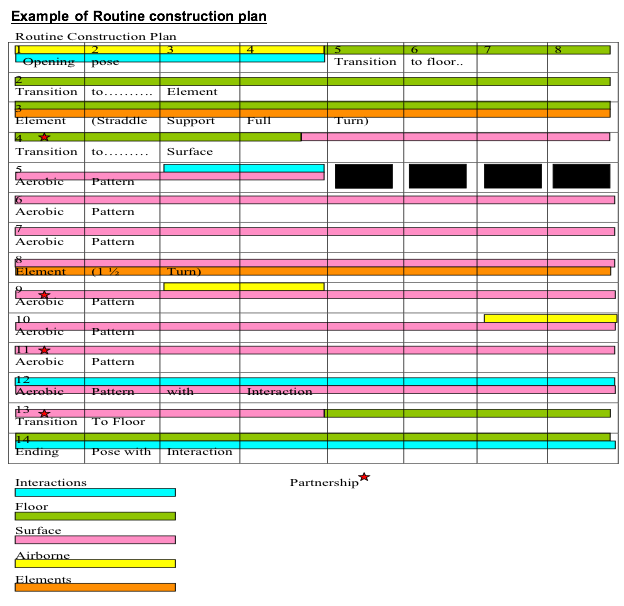CRITERIA
4.1. Use of the competition area and formations
4.2. Distribution of the routine components
4.1. Use of the competition area and formations
4.2. Distribution of the routine components
4.1 Use of the competition area and formation
Throughout the routine, travelling must be shown in all directions (forward, backward, laterally, diagonally and circular) and long and short distances, without repetition of similar traces/tracks. In GR category, only covering the surface is not enough to fulfill the criteria of use of the space; they must travel using the AMP sequences in all the directions and distances.
The competition area must be effectively used throughout the routine with well-balanced structure of the choreography, not only the corners and the center of the competition space but all areas of the competition space.
All three levels (floor-work, standing, airborne) of the competition space must be used. Not more than 32 counts on the floor or in the surface without change the level are recommended.
The competition area must be effectively used throughout the routine with well-balanced structure of the choreography, not only the corners and the center of the competition space but all areas of the competition space.
All three levels (floor-work, standing, airborne) of the competition space must be used. Not more than 32 counts on the floor or in the surface without change the level are recommended.

Formations include positions / positioning of the partners and the way in which they change positions to another formation or in the same formation while they are performing AMP or other movements, and distances between the competitors.
Throughout the routine, different formations and different positions of the team mates must be shown (including distances between gymnasts far versus close)
The formation changes should be fluent.
Throughout the routine, different formations and different positions of the team mates must be shown (including distances between gymnasts far versus close)
The formation changes should be fluent.

4.2. Distribution of the routine components:
All the components of the routine must be properly distributed in both the competition area and the length of the routine
AMP sequences should be distributed and placed in a well-balanced way throughout the routine, without packing more than 3 or 4 AMP sequences performed consecutively as well as not more than 3 elements or other movements performed without any AMP sequence in between.
AMP sequences should be distributed and placed in a well-balanced way throughout the routine, without packing more than 3 or 4 AMP sequences performed consecutively as well as not more than 3 elements or other movements performed without any AMP sequence in between.

The movements must be placed in a balanced way in the competition space (this means for example if there is floor work in the routine, should be placed in different zones). This applies for all the routine components.
SUMMARY
4.1. Use of the competition area and formation:
DEVIATION FROM EXCELLENT (examples)
- With aerobic movement patterns, the competitor(s) did not travel in a variety of distances in different directions.
- Missing travelling trajectory
- Predominating of the circular track/traces
- Use of excessive running/jogging to cover the space
- Groups only cover the competition space and use formation changes but not showing travelling
- Different positions of the competitors
- No formation changes more than 32 counts
- Not showing more than 6 different formation
4.2. Distribution of the routine components:
- Travelling using AMP sequences (long and short distances)
- Use of the competition area and levels
- Different formations / distances
DEVIATION FROM EXCELLENT (examples)
- With aerobic movement patterns, the competitor(s) did not travel in a variety of distances in different directions.
- Missing travelling trajectory
- Predominating of the circular track/traces
- Use of excessive running/jogging to cover the space
- Groups only cover the competition space and use formation changes but not showing travelling
- Different positions of the competitors
- No formation changes more than 32 counts
- Not showing more than 6 different formation
4.2. Distribution of the routine components:
- Well balance structure of the routine
- Place of the movements
DEVIATION FROM EXCELLENT (examples)
- Packing more than 4 AMP sequences
- Packing more than 3 elements without any AMP sequence in between or more than 32 counts without performing any AMP sequence
- Performing only in the narrow range area without making effective use of the space.
- Elements or lifts performed in the same zone of the competition area
- A predominate use of the competition area
- Performing in one level for a long time.
- Packing more than 3 elements without any AMP sequence in between or more than 32 counts without performing any AMP sequence
- Performing only in the narrow range area without making effective use of the space.
- Elements or lifts performed in the same zone of the competition area
- A predominate use of the competition area
- Performing in one level for a long time.
SCALE FOR SPACE
| Excellent 2.0 pt | The routine includes/shows an outstanding, level of the criteria |
| Very Good 1.8 – 1.9 pt | The routine includes/shows high level of the criteria |
| Good 1.6 – 1.7 pt | The routine includes/shows good level of the criteria |
| Satisfactory 1.4 – 1.5 pt | The routine includes/shows average level of the criteria |
| Poor 1.2 – 1.3 pt | The routine includes/shows low level of the criteria |
| Unacceptable 1.0 – 1.1 pt | The routine includes/shows an unacceptable level of the criteria |









